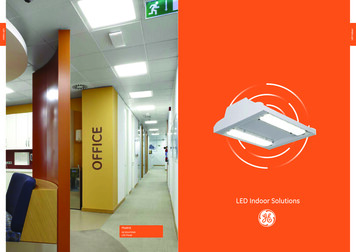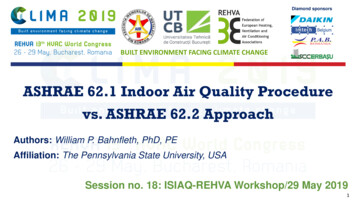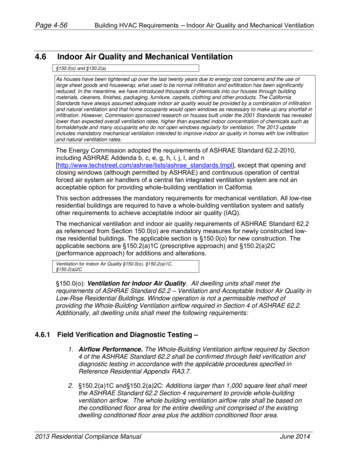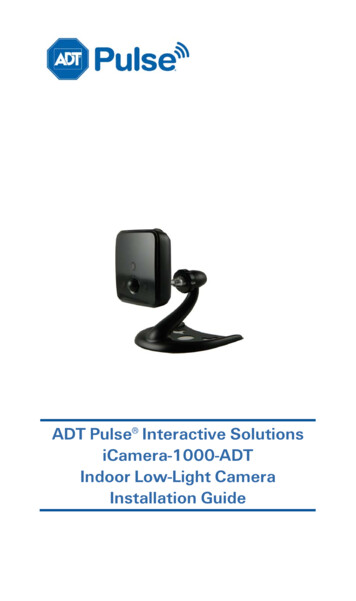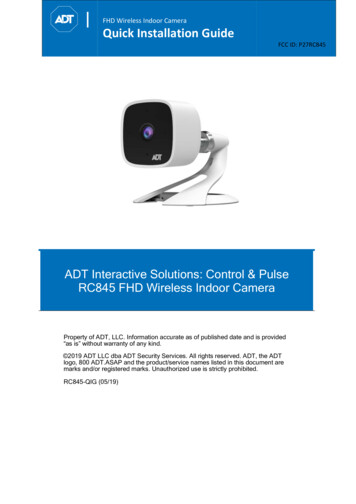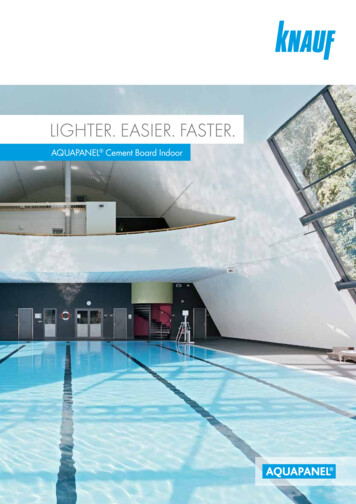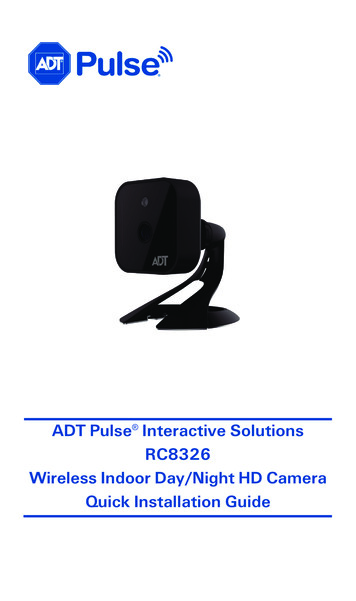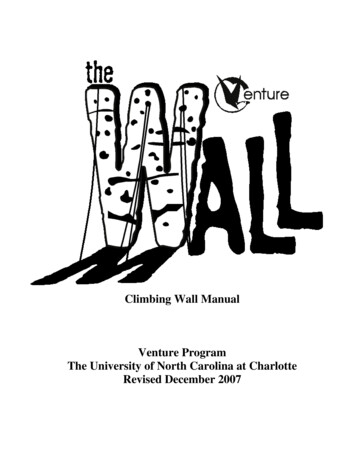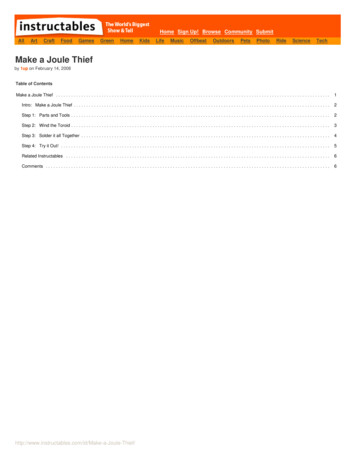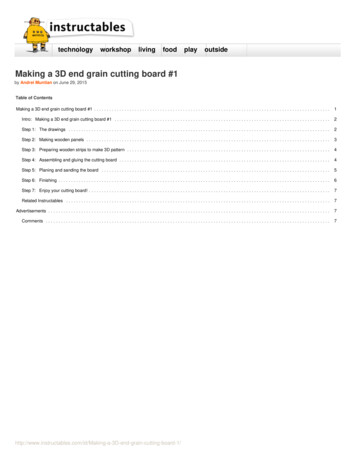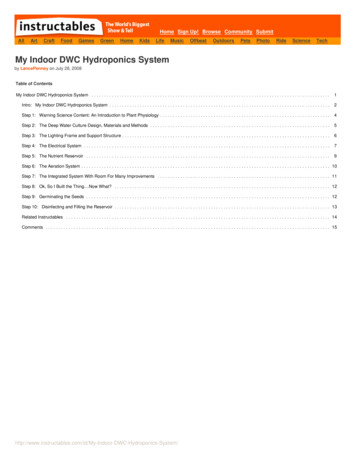
Transcription
Home Sign Up! Browse Community fbeatOutdoorsPetsPhotoRideScienceTechMy Indoor DWC Hydroponics Systemby LancePenney on July 28, 2008Table of ContentsMy Indoor DWC Hydroponics System . . . . . . . . . . . . . . . . . . . . . . . . . . . . . . . . . . . . . . . . . . . . . . . . . . . . . . . . . . . . . . . . . . . . . . . . . . . . . . . . . . . . . . . . . . . . . .1Intro: My Indoor DWC Hydroponics System . . . . . . . . . . . . . . . . . . . . . . . . . . . . . . . . . . . . . . . . . . . . . . . . . . . . . . . . . . . . . . . . . . . . . . . . . . . . . . . . . . . . . . .2Step 1: Warning Science Content: An Introduction to Plant Physiology . . . . . . . . . . . . . . . . . . . . . . . . . . . . . . . . . . . . . . . . . . . . . . . . . . . . . . . . . . . . . . . . . . .4Step 2: The Deep Water Culture Design, Materials and Methods . . . . . . . . . . . . . . . . . . . . . . . . . . . . . . . . . . . . . . . . . . . . . . . . . . . . . . . . . . . . . . . . . . . . . . .5Step 3: The Lighting Frame and Support Structure . . . . . . . . . . . . . . . . . . . . . . . . . . . . . . . . . . . . . . . . . . . . . . . . . . . . . . . . . . . . . . . . . . . . . . . . . . . . . . . . . .6Step 4: The Electrical System . . . . . . . . . . . . . . . . . . . . . . . . . . . . . . . . . . . . . . . . . . . . . . . . . . . . . . . . . . . . . . . . . . . . . . . . . . . . . . . . . . . . . . . . . . . . . . . . .7Step 5: The Nutrient Reservoir . . . . . . . . . . . . . . . . . . . . . . . . . . . . . . . . . . . . . . . . . . . . . . . . . . . . . . . . . . . . . . . . . . . . . . . . . . . . . . . . . . . . . . . . . . . . . . . .9Step 6: The Aeration System . . . . . . . . . . . . . . . . . . . . . . . . . . . . . . . . . . . . . . . . . . . . . . . . . . . . . . . . . . . . . . . . . . . . . . . . . . . . . . . . . . . . . . . . . . . . . . . . . . 10Step 7: The Integrated System With Room For Many Improvements . . . . . . . . . . . . . . . . . . . . . . . . . . . . . . . . . . . . . . . . . . . . . . . . . . . . . . . . . . . . . . . . . . . . 11Step 8: Ok, So I Built the Thing.Now What? . . . . . . . . . . . . . . . . . . . . . . . . . . . . . . . . . . . . . . . . . . . . . . . . . . . . . . . . . . . . . . . . . . . . . . . . . . . . . . . . . . . . . 12Step 9: Germinating the Seeds . . . . . . . . . . . . . . . . . . . . . . . . . . . . . . . . . . . . . . . . . . . . . . . . . . . . . . . . . . . . . . . . . . . . . . . . . . . . . . . . . . . . . . . . . . . . . . . . 12Step 10: Disinfecting and Filling the Reservoir . . . . . . . . . . . . . . . . . . . . . . . . . . . . . . . . . . . . . . . . . . . . . . . . . . . . . . . . . . . . . . . . . . . . . . . . . . . . . . . . . . . . . 13Related Instructables . . . . . . . . . . . . . . . . . . . . . . . . . . . . . . . . . . . . . . . . . . . . . . . . . . . . . . . . . . . . . . . . . . . . . . . . . . . . . . . . . . . . . . . . . . . . . . . . . . . . . . . . 14Comments . . . . . . . . . . . . . . . . . . . . . . . . . . . . . . . . . . . . . . . . . . . . . . . . . . . . . . . . . . . . . . . . . . . . . . . . . . . . . . . . . . . . . . . . . . . . . . . . . . . . . . . . . . . . . . . . droponics-System/
Author:LancePenneyI am a fourth year university student in the science faculty. My major is Biology with a minor in Biochemistry. I live in St.John's, Newfoundland, Canada. Ihave a very big personal drive to live with zero impact to the environment and I think everyone else should too. Therefore I want to try to develop manyprojects relating to green energy and plant growth.Intro: My Indoor DWC Hydroponics System**Update Jan.22 2009**I just harvested my banana peppers and did away with the plants. I now have all the pictures I need to update every section of this instructable so I'll work on that ASAP.Hopefully I'll get a step done every couple of days. I also have a new crop of tomatoes almost ready to go into my new NFT system. Happy growing!This instructable will cover the build and operation of a deep water culture hydroponics system. So far, I have sucessfully grown banana peppers in this setup withcomplete ease since most of the process is automated.Also, these plants were grown indoors completely under artificial light that outputs about 60 watts. The entire unit requires about 65 watts and runs for about 16 hoursevery 24 hours. It costs about 9 cents a day to run it.When I first wrote this instructable it was about a month before I planted anything in it. Since then I have made many modifications to the hydroponics system such as athird light and a more advanced electrical system. I'm soon going to make a fabric cover for it with built in fans for air circulation. As a result you'll see some old and newpictures mixed together. Please bear with me untill I find enough time to re-write the whole thing.Until then, I'll keep posting up-to-date photos of the developing peppers. Enjoy!Image Notes1. I ate one of these guys and it turned out to be sweet. WTF is going on Hydroponics-System/
Image Notes1. This is a waste of biomass for such a small yield of food. I think from now onI'm gonna stick to growing vegetables.Image Notes1. The roots grow out of the rockwool cube and use the clay pellets in the pot toanchor it down.Image Notes1. The roots grow out of the pot and down into the solution with dissolvednutrients.2. Airbars and an air pump provide the roots with oxygen.3. Looks like there's some root rot going on. I think it's because the air pump rancontinuously.Image Notes1. All the light fixtures are wired in from the electronic ballast.2. This outlet is meant to supply electricity to the air pump3. This plug is the input for all of the system's electricity.4. These connectors supply 12 volts DC to the -Hydroponics-System/
Image Notes1. The frame is built mainly from 3/4 inch CPVC pipe and fittings.2. The electrical system is controlled by these switches.3. The frame can be collapsed for easy transport or storage.4. The height of the frame can be adjusted by adding different lengths of verticalpipe.Image Notes1. This is an old picture showing the emergency blankets being used to keepthe light in.Step 1: Warning Science Content: An Introduction to Plant PhysiologyTo the naked or untrained eye, plants can appear as very simple and boring forms of life. In reality, plants are very complex creatures. In fact, genetically speaking plantsare about twice as complex as humans.They exist in two very separate yet two very interconnected and equally important worlds. There is the above ground world of the shoot system and the undergroundworld of the root system.The shoot system of the plant is what we normally see when we look at a plant in the ground. From figure 1B you'll notice that the shoot system is extensively branchedto allow a maximum surface area for the absorption of sunlight. This part contains the leaves, which is where the chemical reaction we learned in junior high takes place:6 CO2 6 H20 6 O2 C6H12O6This chemical process is known as photosynthesis in which the radiant energy from the sun is harnessed and converted into chemical energy in the form of sugars.Excess sugars produced by the plant can be stored in bulk, usually in the form of a fruit that is meant to provide a developing seed with energy until it can grow it's ownleaves and manufacture it's own glucose.The process of photosynthesis is actually much more complex than the above chemical reaction. It is really a series of dozens of chemical reactions that are only a smallpart of a plant's overall metabolism, which requires many other nutrients such as Nitrogen, Potassium, and Phosphorus. But how does the plant collect these nutrients?From it's root system.The root system is responsible for providing the leaves and the rest of the plant with the required raw materials for metabolism and photosynthesis. From figure 1B you'llnotice that the root system is extensively branched to allow a maximum surface area for adequate absorption of water and nutrients from the soil. Anything that isabsorbed by the roots are transported up to the leaves through the plant's stem. In return, some of the oxygen and sugars produced by the leaves are transported downto the roots through the stem. The roots are not exposed to sunlight and therefore cannot manufacture it's own sugars.There are three main problems with soil that limit the growth of a plant:One is that soil does not contain a whole lot of oxygen that the roots need to survive. Roots need to "breathe" just like we do and this can cause a lot of problems whenoxygen is scarce. Hydroponics systems help with this by delivering a highly oxygenated nutrient solution to the roots. This is most commonly achieved through the use ofair pumps and bubblers similar to those used in aquariums.The second problem with soil it that nutrients are often scarce and in a form not usable by the plant. For example, nitrogen in soil is often in the form of ammonia or gasand must be processed by nitrogen fixing bacteria before the plant can use it. Hydroponics systems suspend the roots directly in a nutrient rich solution that can bereadily absorbed by the roots and used for growth.Finally, soil can contain many pathogens that can lead to diseased plants. Hydroponics solutions can be easily sterilized to prevent any nasty creatures from infectingyour plants.By addressing these three problems, hydroponics allows plants to grow and develop at an accelerated rate. With all that being said, I finally give to you my design of anindoor Deep Water Culture (DWC) hydroponics WC-Hydroponics-System/
Step 2: The Deep Water Culture Design, Materials and MethodsPlease refer to figure 2A for an illustration of the DWC system.In Deep Water Culture (DWC) systems the plant sits in a mesh basket filled with an inert medium such as clay pellets. The inert medium does not provide the plants withnutrients but only acts as a support to anchor the plant down.The basket is suspended in a reservoir filled with a solution of nutrients. As the plant grows, the roots will protrude through the holes in the basket down into the nutrientsolution where they can be readily absorbed. (Figure 2B)At the bottom of the reservoir sits an airstone hooked up to an aquarium pump. Air is bubbled through the solution and up to the roots to provide them with oxygen.Although the leaves must be exposed to light, the walls of the reservoir must be opaque to prevent the nutrient solution from being exposed to light. Not only can roots bedamaged by light but light in the reservoir will promote the growth of alge which is harmful to the plant.The nutrient solution must be changed on a regular basis because the nutrients can be used up and "nutrient toxicity" can occur. Also, the pH of the solution tends to goup as the plants use up the nutrients. It can rise to extreme levels and end up killing the plant.There are many versions of the DWC system available for retail but they are expensive and aren't DIY. I made mine from materials available at any Canadian Tire andWal-Mart. Please note that I got the idea for the reservoir system from this build by trebuchet03 entitled Hydroponics - at Home and for Beginners .I encourage you all to design your own DWC system, using this instructable only as a guide to expand and improve on my design. With that being said I will still provide acomplete list of the materials I used below.Lighting Frame and Supporting Structure:3/4 inch CPVC pipe3/4 inch CPVC tees3/4 inch CPVC 90 degree elbows1/2 inch CPVC pipe1/2 inch CPVC tees1/2 inch CPVC 90 degree elbows1/2 inch PVC Conduit BoxesPVC primerPVC solvent cementElectrical, Wiring and Lighting:24 inch fluorescent light fixtures24 inch fluorescent grow lights18 gauge wire in black, red and green spoolsA grounded plug that can be self-wiredRocker switch rated for at least 125VAC at 1 ampProgrammable timer*Wire connectorsElectrical tapeZip tiesVinyl shrink tubingA firm knowledge of Ohm's law, circuit wiring and electrical safetyAeration:Aquarium air pumpAquarium air tubingAquarium air barsAir tubing shut-off valvesZip TiesNutrient Reservoir, Solution and Growth Media:27 litre storage tote with lidCan of black spray paint5 inch mesh baskets*Expanded Clay Pellets*General Hydroponics FloraGro concentrated nutrients*General Hydroponics FloraBloom concentrated nutrients*General Hydroponics FloraMicro Concentrated Nutrients*Syringe** For those of you that live in the St.John's, Newfoundland area, I recommend dropping by Grow Crazy . I got a lot of my materials there that I would otherwise have toget shipped in from the USA. The guy there is very helpful and there's a great selection of nutrients and equipment for any C-Hydroponics-System/
Image Notes1. Looks kinda like an upside-down bush without the leaves.Step 3: The Lighting Frame and Support StructureThe main purpose of the lighting frame is to suspend the fluorescent light fixtures over the plants in the nutrient reservoir. I also designed it to be adjustable in hieght sothat the lights remain only a few inches above the plants at all times. Also, I can hang some chicken wire or string from the top of the frame to help support the plant ifneeded.The frame is constructed completely out of 3/4 inch CPVC pipe and fittings. There is also the 1/2 inch PVC electrical conduit boxes making up two of the top corners.These boxes house the on/off switch for the lights and all the electrical connections.The top and the bottom portions of the frame are permanantly assembled with the CPVC cement. However, the vertical sections of the frame are not glued in. This allowsthe frame to be easily adjusted in height by adding or subtracting lengths of vertical pipe through the use of 3/4 inch couplings. The frame can also be easliy collapsed forstorage or transport. (Figure 3B).For some weird reason the 3/4 inch pipe fits almost perfectly into the 1/2 inch conduit boxes. However, I did have to sand down the pipe a tiny bit before it fit into theconduit box.When cutting the pipe make sure you use a mitre block and deburr the pipe with sandpaper prior to glueing. Dry fit the pipes before priming and glueing.The support structure is ment to hold the airbars in place underneath the mesh pots and to prevent the lid of the reservoir from sagging under the weight of the plants. Itstraddles both airbars and holds them far enough apart so that they line up underneath both rows of mesh pots. It is just the right hieght so that it holds the reservoir lidlevel. (Figure 3C).The support structure is constructed of 1/2 inch CPVC pipe and fittings. You could make it out of leftover 3/4 inch pipe and fittings from the lighting frame but in my casethe 1/2 inch fittings fit around the airbar better. I did not glue this one together, it holds together just fine without glue.Image Notes1. 3/4 inch CPVC tee and elbow2. Conduit boxes make up two DWC-Hydroponics-System/
Image Notes1. Centre of lid held up hereStep 4: The Electrical SystemThe electrical system consists of the three fluorescent lights, the two on/off switches, the plug, the outlet, the fuse and the wires. It allows the unit to be plugged into anystandard wall outlet while the lights and auxillary outlet can be controlled by the toggle switches (Figure 4B).Even though the light fixtures are ment to be celing mounted and wired directly into the house's electrical grid, I wired them with the plug so that this unit could be easilydisconnected and then transported or stored. The use of a wall outlet for power also enables a standard programmable timer to automaticly control all of the electronics(Figure 4C).This step is critical in terms of safety. If you wire this wrong or allow any exposed terminals to cross, you could start an electrical fire. An electrical fire couldalso result from using wire that is not rated high enough for the current and voltage loads that these devices require. Obviously, you also run the risk ofgetting an electric shock. MAKE SURE YOU KNOW WHAT YOU'RE DOING!!Each of these lights require 120VAC and run at 20 watts. Using Ohm's law ( I P/E 20W/120V 0.167A) I know that each light will draw a current of 0.167 amps. Thelights are wired in parallel so that the voltage does not divide between them. This means that the main power cord will carry a current of 0.5 amps. The 18 guage hook upwire that I used was rated for a maximum current of 2.32 amps so it should be safe.The wire came in a package with three colors. I used black for the live wire, red for the neutral wire and green for the ground wire. It is important to stay consistent withthis or you could wire it up wrong and end up in big trouble when you plug it in and flip the switch.When making connections, only splice a small portion at the top of the wire. Hold the two ends together and slip a wire connecter over them. Twist the connecter andyoure done. Make sure you cover any exposed parts of the wire with electrical tape.In the fluorescent light housing you'll find the live and the neutral wires coming out of the electronic ballast box. The ground wire should be connected to a metal part ofthe housing (Figure 4D) When you're looking at a standard north american wall outlet, the neutral hole is on the left, the live on the right and the ground on the bottom.This should be kept in mind when wiring up the plug and the outlet. Please note that a plug and an outlet face each other so the live and the neutral wires are on oppositesides(Figure 4E).The main power cord runs from the plug into the main electrical box. This box is the main hub of power distribution for the electrical system. Inside, all like wires from themain power cord, the light power cord and the outlet power cord are connected in parallel. The live wire for the main power cord is interrupted by a 2 amp fuse beforebeing connected to the other power cords. The live wires for the lights and the outlet are interrupted by a toggle switch before contuining to their respective loads (Figure4F).Three wires from the light power cord and three wires from each light run into the left conduit box (Figure 4G). From here it's just a matter of using wire connecters toconnect all three wires of each color(Fighre 4H). **Please note that Fig 4H only shows the connections for two lights, I'll update soon!**To make everything nice and neat I used electrical tape to bundle each set of wires from the lights and power cord. I used zip ties to secure the bundles to the frame. Ialso used a piece of shrink tubing to cover the wires running from the plug to the first conduit box (Figure 4I).You'll notice that the entire electrical system is contained within the top portion of the frame. This allows the frame to be taken apart without having to disturb any wires.When I first turned the unit on I monitored it very closely for hours. I inspected it frequently for signs of electric arcing or current overload. I also felt the wires every coupleof minutes to ensure they wern't heating up. Fortunately, everything ran -DWC-Hydroponics-System/
Image Notes1. The air pump is plugged in here.2. The power is supplied to the unit from this plug.3. These switches control the lights and the outlet.Image Notes1. This timer can be set to turn the power on or off any time of day2. Manual on/off switch.3. Electrical system plugs into here and the timer plugs into the wall outlet.Image Notes1. Live and neutral wires come from the electronic ballast.2. Ground wire comes from the metal casing.Image NotesImage -Hydroponics-System/
1. This is the outlet.2. This is the plug.3. Neutral wire.4. Ground wire5. Live wire1. Live wires for each load is interrupted by the switch2. Live wire for the main power cord is interrupted by the 2 amp fuse3. Main power cord on it's way in and the outlet cord is on it's way out.4. Light power cord is on it's way out5. All like wires are connected in parallel.6. With the new setup I can remove the cover and service the inside withoutdisturbing the wires.Image Notes1. Cord from nearest light enters2. Cord from the other two lights and the main light power cord enters.Step 5: The Nutrient ReservoirThe nutrient reservoir is built out of a storage tote and 5 inch mesh pots. The pots are nested in holes in the lid of the tote so that they are partially suspended in thenutrient solution in the tote. It allows for the plant's roots to grow down into the solution while the shoot system grows up into the light.I picked the tote so that the lid would hold six pots in two rows of three. Four of the pots are located in the extreme corners of the lid and the other two spaced evenlybetween them. This maximizes the space between plants.The pots are not prefectly cylindrical in shape. The radius of the top is bigger than the radius of the bottom. I traced out the tops of the pots on the lid of the tote and cutout the holes with a utility knife. The holes are sightly smaller than the traces so that the lip of the pot catches on the edge of the hole and does not fall into the reservoir.The reservoir must be deep enough so that there is a gap between the bottom of the pots and the top of the air bars.When I bought the tote it was transparent. I coated the tote and lid with a can of black spray paint to prevent any light from reaching the inside of the reservoir. However, Ithink a roll of duct tape would work just as well or better.Finally, two holes were drilled in the side of the tote as close to the top as possible. The air lines are run through these holes so that taking of the lid of the tote does notdisturb the air lines (Figure 5C).Image Notes1. Support structure seen through the mesh potImage Notes1. Reminds me of a six pack of beer Hydroponics-System/
Image Notes1. Nutrient solution will eventually go hereStep 6: The Aeration SystemThe Aeration System is set up to deliver a continuous, controlled airflow into the nutrient solution. It is made up of the air pump, air tubing, shut-off valves and airbars(Figure 6B).The air tubing came packaged in a tightly wound coil. This was very cumbersome to work with because the tubing always tends to spring back into that shape. I let thetubing soak in a bowl of hot water for a few minutes and then stretched it out while it was still hot. When it cooled the tubing remained straight and was much easier towork with.Between the air pump and the airbars, the tubing is interrupted by the shut-off valves. The rate of airflow into each airbar can be easily adjusted by twisting the knobs onthe valves.From the valves the tubing is fed through the holes in the side of the reservoir and into each airbar. the tubing runs through the side of the reservoir rather than the lid sothat the lid can be removed without disturbing the air lines (Figure 6C).Finally, the airbars are positioned so that they line up underneath all six of the mesh pots. From there they distribute air evenly to each plant (Figure 6D).Image Notes1. Monsterous air pump2. Airflow for each airbar controlled from Hydroponics-System/
Image Notes1. Those roots are sure gonna like this!Step 7: The Integrated System With Room For Many ImprovementsAnd there you have it, when you put everything together you end up with a freakin' awesome DWC hydroponics system.However, I barely have it finished and I can already think of a few improvements to be made: Integrating the air pump's power cord into the electrical system so that it can be controlled via an on/off switch. (DONE) Painting the lid of the reservoir white so that it reflects light back up to the plant rather than absorbing it. Running all of the wires through the CPVC pipe for an even neater look. Adding a water pump to circulate the nutrient solution through a UV sterilizer to keep out unwanted organisms. Sewing together a fabric cover to slip over the frame and help keep out ambient light while trapping in growing light. (In Progress) Addition of a third growing light. (DONE) Adding solar cells, a battery bank and a power inverter to make it run on free electricity. (In Progress) And of course, expansion, expansion, expansion!I will soon add some more steps on mixing the nutrient solution, testing and adjusting the pH, setting the light timer and eating fresh picked vegetables whilist up to myears in snow!Thank you for reading. I hope you enjoyed this instructable and I welcome any constructive feedback. Happy DWC-Hydroponics-System/
Step 8: Ok, So I Built the Thing.Now What?Well now I have to grow something in it or else it would be a terrible waste of time and effort. Even though hydroponics is a relitively easy and sucessful method ofgrowing, it still requires a signifigant effort and regular care and maintenence. The following steps should provide some insight into the things that need to be done togrow a plant hydroponicly.But I can't do anything untill I have a plant to grow and the selection of that plant is important. Each plant has specific requirements that have to be met such as the pH ofthe nutrient solution, the size of the setup, the spacing between plants, the amount of light, etc. You should do your own research on any plant you may be thinking aboutgrowing hydroponicly. My first selection of plants were banana peppers for three main reasons:1)I love spicy food and I like hot peppers as a topping on just about anything.2)This is a fruit producing plant so I can test how adjusting the timing of the lights will affect the onset of the different stages of the plant's growth.3)This plant produces it's fruit above the ground. I don't think plants that produce sub- teranian food like carrots and potatoes would be suitable for this type of application.So in order to get the pepper I need to start with the seed. Read on to find out how.Image Notes1. Here, in this very spot will soon rest my first crop, banana peppers!Step 9: Germinating the SeedsI've read a lot about how seed germiation is a complex and delicate process where only the most talented gardener can hope to have a 50% sucess rate. In my personalexperience it was easy and I've almost never had a seed that did not germinate. You just need a few simple materials that are easy to obtain from any department storearound spring and summer.The main requirements are (Figure 9A and 9B): A humidity dome. This is basically a mini greenhouse that allows sunlight to enter and keeps moisture in. A developing seed's worst nightmare is drying out. These canbe bought for pretty cheap but I've used cake domes and chicken domes before and they worked just fine. Rockwool cubes. It's just a piece of fibreglass-like-material with a hole in the middle. They hold in moisture well, are breatheable and allow the rootst easily grow throughthem. Peat pellets work great too but are not suitable for hydroponics setups. Some plant food. There's all sorts of fancy and expensive formulas especially for starting seeds but I just use the good ol' general purpose plant food. Just mix it withwater in a spray bottle and use it whenever you water the plants.Start by soaking the rockwool cubes in the plant food solution for a few minutes. Remove them from the solution and lay them in the bottom of the humidity dome. Drop aseed into the hole in the cube. Place the lid on the humidity dome and leave it in a sunny location indoors.The seeds will need to be watered daily. A lot of condensation will collect on the lid of the dome. I just shake the condensation into the sink and mist the cubes a couple oftimes. Repeat this as long as they are inside the dome.When roots are protruding from the bottom and sides of the cubes and they have developed a pair of secondary leaves, they are probably ready to be transfered to thehydroponics system (Figure 9C). It is now time to disinfect the nutrient reservoir and fill it with -DWC-Hydroponics-System/
Image Notes1. Clear plastic dome lets light in and traps moisture. The black bottom absorbslight and warms up the seedlings.Image Notes1. Plant food2. Rockwool Cubes3. My first cropImage Notes1. One of the primary leaves2. One of the secondary leavesStep 10: Disinfecting and Filling the ReservoirThe Nutrient Reservoir can become quite a utopia for all sorts of nasty microorganisms that can wreak havoc on your plants. If I've only learned one thing from my yearsworking in microbiology labs it's that they are persistent little buggers. If you give them half a chance they will take over your entire setup in no time flat. There's no waythat you can completely suppress them, but you can prevent them from flourishing with a few simple preventative measures.First of all, the reservoir and growth medium has to be disinfected prior to use. All you need is a bathtub, some hot water and some chlorine bleach. The clay pellets acovered in dust before their first use so I rinsed them off before filling each mesh basket with them (Figure 10B). I laid all six mesh baskets in the empty reservoir andthen added a generous portion of chlorine bleach. I filled the reservoir with hot water and let the whole thing sit for about an hour. Then I gave everything a quick rinseand it was ready to be filled.The water level here is important. At first the roots probably won't be sticking out of the rockwool cubes so you should fill the reservoir up to soak the cubes directly. Asthe roots grow
oponics-System/ Image Notes 1. This is a waste of bi

